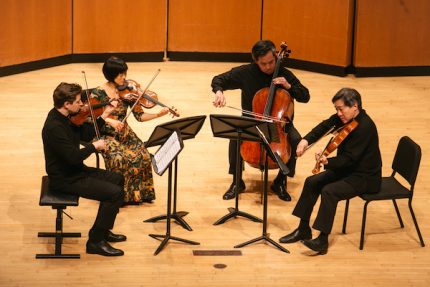Ying Quartet brings venturesome program to Winter Chamber Music Festival

“What a pleasure it is to play in front of real people again,” said a grateful Philip Ying of the Ying Quartet at Sunday night’s concert at the Winter Chamber Music Festival. As the group’s violist noted, most of their performances have been online during the past two years of the pandemic.
The anticipated return of Northwestern’s annual January festival at Pick-Staiger Hall has not been immune to Covid-19. The Omicron surge caused the opening weekend to be cancelled, reducing the 2022 festival to just three events.
Yet with a nicely diverting program, the Ying Quartet’s dedicated performances continued the high level of music-making from the Miró Quartet the previous evening.
The concert also marked a homecoming of sorts for the three original members of the group. The Ying siblings grew up in Winnetka and attended the North Shore Center for the Performing Arts (now the Music Institute of Chicago).
Music of Haydn opened the evening and his Quartet in G minor (“The Rider”), Op. 74, no. 3, made a fine calling card for the ensemble. From the brusque opening bars, the group proved fully in synch with Haydn’s style, their light, silvery sonority capturing the galant essence of the lilting second theme. The Adagio explores a deeper vein of expression than many Haydn quartets and, led by the group’s excellent first violinist Robin Scott, the quartet rendered the slow movement with an ideal blend of expressive poise and tonal refinement.
The Minuet could have used greater rhythmic bite, yet no complaints about the finale with the players handling the racing frenzied music that gave the work its title with technical poise, along with the abrupt pauses and syncopations.
The middle section of the program offered a kind of musical Dim Sum, as the group’s violist joked, with a sampler of music by a trio of contemporary Chinese composers.
Zhou Long’s Song of the Ch’in is based on the Chinese poem, “Old Fisherman,” Pizzicatos on the violins usher in a dark-hued viola solo, the music later segueing into an uptempo section including rhythmic slaps on the body of the cello. If Long’s work goes on a bit too long for what it has to say, there are beautiful moments and the Ying members conveyed its stately melancholy as well as the zither-like quality of the title stringed instrument.
Three excerpts from Tan Dun’s Eight Colors for String Quartet, showed that composer’s gift for strong ideas and unique instrumental writing even in a brief span. Each movement was inspired by elements of Chinese opera, as well as Buddhist chanting with a dash of atonality.
The Ying players gave these concise interludes atmospheric and concentrated advocacy. “Drum and Gong” offered artful and precise rhythmic pizzicatos and the musicians explored a wide array of dynamics and timbral effects in “Cloudiness.” “Red Sorghum,” concludes the Tan Dun set with a jumpy, angular finale and abrupt coda.
The sound of the gamelan inspired Pizzicato by the Chinese-Canadian composer Vivian Fung. No bows used again here as the title suggests, though Fung avoids plucked monotony with witty, rapid-fire writing and insistent energy. The musicians brought game vitality to this showpiece, at one point drawing a striking array of dynamics from finger drumming on their instruments.
Of all the great composers, none has left as strong a chamber music legacy that still remains largely unexplored than Antonín Dvořák. The Czech composer wrote fourteen string quartets, thirteen of which are almost never performed. Yet the quality of these works is consistently high with the greatest of them—like No. 9 in D minor, written after the death of his daughter—exploring a remarkable depth of emotion.
Kudos to the Ying Quartet for giving us not the tuneful but overplayed “American” quartet, but one of Dvořák’s neglected works in the genre, the Quartet No. 11 in C major, Op. 61.
The C-major quartet is written on a grand scale spanning 40 minutes, yet taut in construction. As in his finest mature works, the music blends a gracious Bohemian lyricism with dramatic toughness. A pensive, unsettled quality dominates the expansive opening movement despite the surface amiability.
The Ying Quartet’s playing was characteristically polished and sensitive, as in the Poco adagio, which offers one of the composer’s most indelible lyrical meditations. They were fully in synch with the Czech folk influences as well as the dramatic give and take.
Still at times, one couldn’t help feeling that the full range and expressive possibilities of this score were somewhat untapped. The desperate, frenzied outburst before the quiet coda of the opening movement was far too low-key. And in the slow movement and vibrant finale, the musicians at times appeared to be feeling their way through the score without a sustained level of concentration or intensity.
That said, this was still an admirable and accomplished performance—with especially fine solo moments by violinist Scott—and one that likely introduced many in the audience to this rarely heard Dvořák music.
With a jazzy, spirited encore of John Novacek’s rag, The Atlantic Side-Step, the Ying musicians sent the audience out fortified into the chilly lakefront air.
The Winter Chamber Music Festival concludes February 15 with the Dover Quartet performing music of Haydn, Shostakovich and Britten. music.northwestern.edu
Posted in Uncategorized